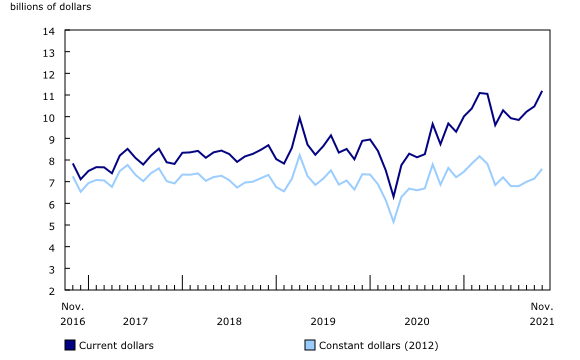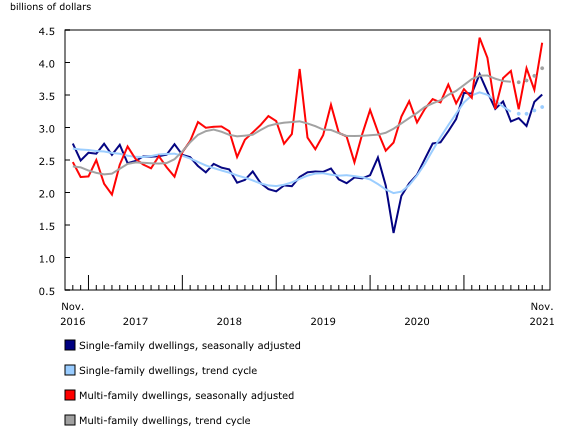Building permits, November 2021
Archived Content
Information identified as archived is provided for reference, research or recordkeeping purposes. It is not subject to the Government of Canada Web Standards and has not been altered or updated since it was archived. Please "contact us" to request a format other than those available.
Released: 2022-01-05
$11.2 billion
November 2021
6.8% 
(monthly change)
$31.3 million
November 2021
-9.7% 
(monthly change)
$54.8 million
November 2021
67.9% 
(monthly change)
$275.4 million
November 2021
35.5% 
(monthly change)
$120.7 million
November 2021
-3.9% 
(monthly change)
$2,447.3 million
November 2021
9.5% 
(monthly change)
$4,542.7 million
November 2021
1.4% 
(monthly change)
$331.6 million
November 2021
-0.5% 
(monthly change)
$191.4 million
November 2021
49.5% 
(monthly change)
$1,323.0 million
November 2021
20.6% 
(monthly change)
$1,861.5 million
November 2021
5.1% 
(monthly change)
$11.2 million
November 2021
-60.4% 
(monthly change)
$1.4 million
November 2021
-55.6% 
(monthly change)
$0.0 million
November 2021
...%
(monthly change)
The total value of building permits increased 6.8% to $11.2 billion in November. Seven provinces, led by Alberta (+20.6%) reported increases. Construction intentions in the residential sector rose 12.0% while the non-residential sector declined 3.4%.
On a constant dollar basis (2012=100) building permits increased 6.3% to $7.6 billion.
Residential sector up for a third consecutive month
Construction intentions for the residential sector increased 12.0% to $7.8 billion at the national level, reaching the highest level since the record set in March 2021. Growth in the sector was driven mostly by British Columbia (+31.7%).
The total value of multi-family permits bounced back 20.2% after the previous month's 8.5% decline. A $256 million permit for the Plaza One residential tower in Surrey pushed British Columbia 53.9% higher for the month.
Permits for single family homes rose 3.3%, reflecting strength in Ontario (+4.2%) and Quebec (+8.3%). In Nova Scotia, the value of single-family permits rose 35.9% to a record value of $118 million in November.
Institutional component weighs down non-residential sector
The value of institutional permits fell 49.2% in November to $613 million, reversing October's strong growth. This was the lowest level for institutional permits since April 2020.
Construction intentions in the commercial component rose by 14.3%. Alberta (+140.2%) led the growth, with a $316 million permit approved for the BMO convention centre expansion in Calgary.
Industrial permits rose 45.1% in November following a strong downturn in October. Much of the growth was from Ontario (+98.0%), where permits reached their highest level since August 2019.
Despite notable growth in the commercial and industrial components, the non-residential sector declined 3.4% overall in November.
To explore data using an interactive user interface, visit the Building permits: Interactive Dashboard.
To explore the impact of COVID-19 on the socioeconomic landscape, please consult the Canadian Economic Dashboard and COVID-19.
For more information on housing, please visit the Housing Statistics portal.
Statistics Canada has a Housing Market Indicators dashboard. This web application provides access to key housing market indicators for Canada, by province and by census metropolitan area. These indicators are updated automatically with new information from monthly releases, giving users access to the latest data.
Note to readers
Unless otherwise stated, this release presents seasonally adjusted data with current dollar values, which facilitate month-to-month and quarter-to-quarter comparisons by removing the effects of seasonal variations. For information on seasonal adjustment, see Seasonally adjusted data – Frequently asked questions.
Starting with the March 2021 reference period, monthly constant dollar estimates are available for the entire data series (34-10-0066-01). Constant dollars remove the effects of price changes over time and are calculated using quarterly deflators from the Building Construction Price Index (18-10-0135-01). Typically, the first two months of a quarter use the previous quarter's price level and are revised when the new quarterly price index becomes available.
Building components
- Single-family dwellings: Residential buildings containing only one dwelling unit (e.g., single-detached house, bungalow, linked home [linked at the foundation]).
- Multi-family dwellings: Residential buildings containing multiple dwelling units (e.g., apartment, apartment condominium, row house, semi-detached house).
- Industrial buildings: Buildings used in the processing or production of goods, or related to transportation and communication.
- Commercial buildings: Buildings used in the trade or distribution of goods and services.
- Institutional and government buildings: Buildings used to house public and semi-public services, such as those related to health and welfare, education, or public administration, as well as buildings used for religious services.
Revision
Unadjusted data for the current reference month are subject to revisions based on late responses. Data for the two previous months have been revised. Seasonally adjusted data for the previous three months have also been revised.
Trend-cycle estimates have been added to the charts as a complement to the seasonally adjusted series. Both seasonally adjusted data and trend-cycle estimates are subject to revision as additional observations become available. These revisions could be large and could even lead to a reversal of movement, especially at the end of the series. The higher variability associated with trend-cycle estimates is indicated with a dotted line on the charts.
For information on trend-cycle data, see the StatCan Blog and Trend-cycle estimates – Frequently asked questions.
Next release
Data on building permits for December 2021 will be released on February 2nd, 2022.
Contact information
For more information, or to enquire about the concepts, methods or data quality of this release, contact us (toll-free 1-800-263-1136; 514-283-8300; infostats@statcan.gc.ca) or Media Relations (statcan.mediahotline-ligneinfomedias.statcan@statcan.gc.ca).
- Date modified:





